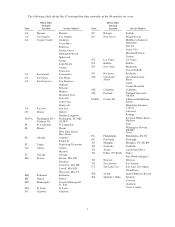XO Communications 2010 Annual Report Download - page 20
Download and view the complete annual report
Please find page 20 of the 2010 XO Communications annual report below. You can navigate through the pages in the report by either clicking on the pages listed below, or by using the keyword search tool below to find specific information within the annual report.Mbps (megabits per second). One million bits of information per second. The information carrying
capacity of a circuit may be measured in Mbps.
MPLS,orMulti-Protocol Label Switching. A standards-approved technology for speeding up
network traffic flow and making it easier to manage. MPLS involves setting up a specific path for a given
sequence of packets, identified by a label put in each packet, thus saving the time needed for a router or
switch to look up the address to the next node to forward the packet to.
Node. A point of connection into a fiber optic network.
OC-192. A data communications circuit capable of transmitting data at approximately 9.9 Gbps.
Peering. The commercial practice under which ISPs exchange traffic with each other.
Point-of-Presence, or POP. Collocation centers located centrally in an area where
telecommunications traffic can be aggregated for transport and distribution.
Private Bank eXchange, or PBX. An in-house telephone switching system that connects office
telephones with each other as well as to the outside PSTN. IP PBXs support VoIP by converting them
into traditional circuit-switched TDM connections.
Private Line Dedicated Transport Services, or Private Line. A private, dedicated
telecommunications link between different customer locations.
Provider Edge. A Provider Edge (PE) router or switch is service provider equipment that
terminates customer access circuits and provides packet network ingress and egress functionality such as
rate shaping, policing, packet classification and on the like. PE routers typically connect to larger
Provider (P) routers that carry large traffic aggregates across the wide area. P-routers do not directly
terminate customer connections.
Public Switched Telephone Network, or PSTN. The switched network available to all users
generally on a shared basis.
Reciprocal Compensation. An arrangement in which two local exchange carriers agree to terminate
traffic originating on each other’s networks in exchange for a negotiated level of compensation.
Route Mile. The number of miles along which fiber optic cables are installed.
Router. Equipment placed between networks that relay data to those networks based upon a
destination address contained in the data packets being routed.
SaaS, or Software-As-A-Service. Software that is rented as opposed to purchased. Since SaaS is
subscription based, all upgrades are provided during the subscription term.
Synchronous Optical Network, or SONET. A set of standards for optical communications
transmission systems that define the optical rates and formats, signal characteristics, performance,
management and maintenance information to be embedded within the signals and the multiplexing
techniques to be employed in optical communications transmission systems. SONET facilitates the
interoperability of dissimilar vendor’s equipment. SONET benefits business customers by minimizing the
equipment necessary for various telecommunications applications and supports networking diagnostic and
maintenance features.
Switch. A mechanical or electronic device that opens or closes circuits or selects the paths or
circuits to be used for the transmission of information. Switching is a process of linking different circuits
to create a temporary transmission path between users.
T1. A data communications circuit capable of transmitting data at 1.544 Mbps.
Tbps (terabits per second). 10
12
bits of information per second. The information carrying capacity
of a circuit may be measured in Tbps.
16
























